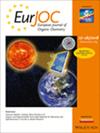含硒和多酚的新糖缀合物。类振子重排立体选择性合成
IF 2.5
3区 化学
Q2 CHEMISTRY, ORGANIC
引用次数: 0
摘要
在过去的20年里,硒基化合物的抗氧化活性的开发得到了改进,这仅仅是因为使用了硒化合物Ebselen作为谷胱甘肽过氧化物酶(GPx)的模拟物。然而,它们的临床应用似乎因其在水中的低溶解度而受到损害。利用含硒糖的新方法来解决这个问题是可能的,其中硒取代了杂环氧。在此框架下,为了优化硒糖的抗氧化性能,本研究考虑了糖与多酚单位的缀合,多酚单位是一种能够抑制或使自由基丧失作用的分子。利用Mitsunobu反应机制,将来自市售d-甘露糖的硒基糖基给体的初级醇功能与酚基部分受体共价连接,得到相应的糖缀合物,从而获得高效产率的产物。为了了解硒给体对反应性的可能影响,进行了DFT理论研究。至关重要的是,一种基于类似pummer的重排和糖基化的新途径产生了一种硒糖,它的环上有硒,在C-1上有一个类似缩醛的官能团。所有化合物均经核磁共振波谱表征,证实了其结构和纯度。本文章由计算机程序翻译,如有差异,请以英文原文为准。
New Glycoconjugates Containing Selenium and Polyphenols. Stereoselective Synthesis by Pummerer-like Rearrangement
In the last 20 years the exploitation of antioxidant activity of selenobased compounds has improved, just due to the use of Ebselen, a selenocompound, as a Glutathione peroxidase (GPx) mimic. However, their clinical use seems to be compromised by the low solubility in water. To deal with this problem is possible to take advantage of the new approach including selenosugars in which selenium replaces heterocyclic oxygen. In this frame, to optimize the antioxidant properties of selenosugars, the glycoconjugation with a polyphenolic unit, which is a molecule capable of inhibiting or disabling the action of free radicals, has been considered in this work. The Mitsunobu reaction mechanism links covalently the primary alcoholic function of selenobased glycosyl donors, coming from the commercially available d-mannose, and phenolic moiety acceptors, to obtain the corresponding glycoconjugates, has been exploited affording the products in efficient yields. A DFT theoretical study was carried out to help understand the possible influence of the seleno donor on the reactivity. Crucially, a new pathway based on Pummerer-like rearrangement followed by a glycosylation, gave a selenosugar with selenium in the ring and bearing an acetal-like functional group at C-1. All compounds were characterized by NMR spectroscopy confirming their structures and purity.
求助全文
通过发布文献求助,成功后即可免费获取论文全文。
去求助
来源期刊
CiteScore
5.40
自引率
3.60%
发文量
752
审稿时长
1 months
期刊介绍:
The European Journal of Organic Chemistry (2019 ISI Impact Factor 2.889) publishes Full Papers, Communications, and Minireviews from the entire spectrum of synthetic organic, bioorganic and physical-organic chemistry. It is published on behalf of Chemistry Europe, an association of 16 European chemical societies.
The following journals have been merged to form two leading journals, the European Journal of Organic Chemistry and the European Journal of Inorganic Chemistry:
Liebigs Annalen
Bulletin des Sociétés Chimiques Belges
Bulletin de la Société Chimique de France
Gazzetta Chimica Italiana
Recueil des Travaux Chimiques des Pays-Bas
Anales de Química
Chimika Chronika
Revista Portuguesa de Química
ACH—Models in Chemistry
Polish Journal of Chemistry.

 求助内容:
求助内容: 应助结果提醒方式:
应助结果提醒方式:


